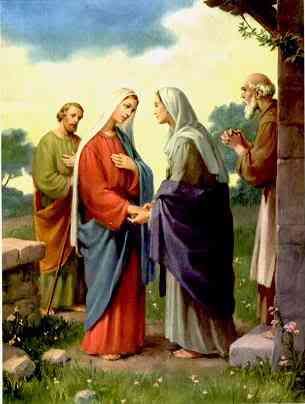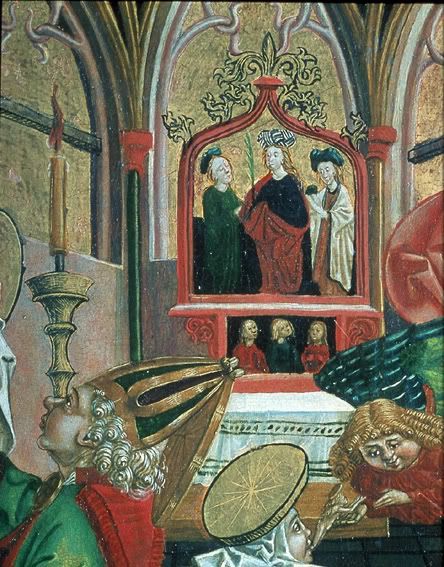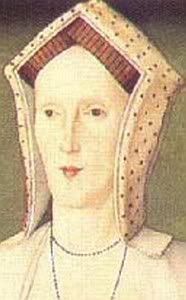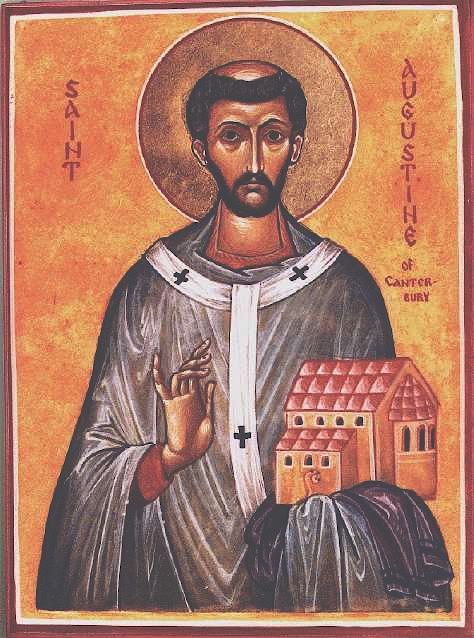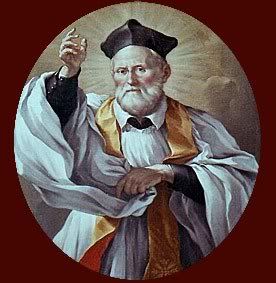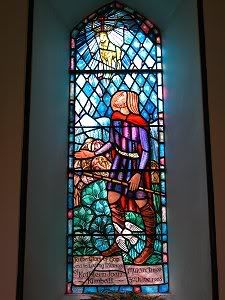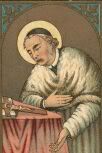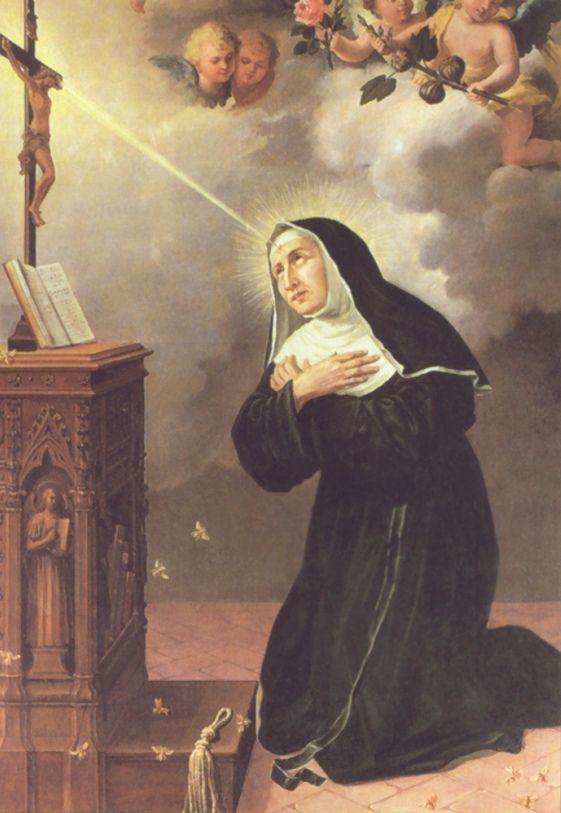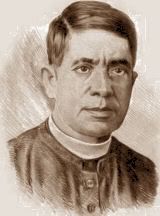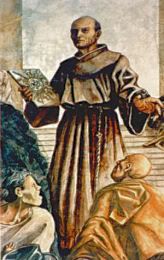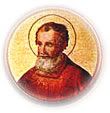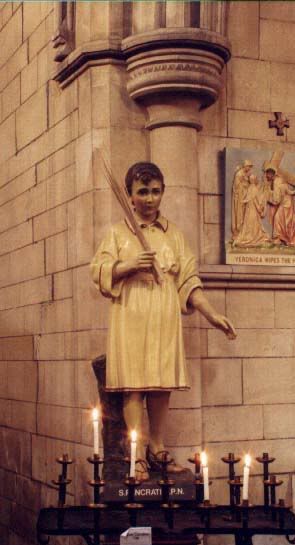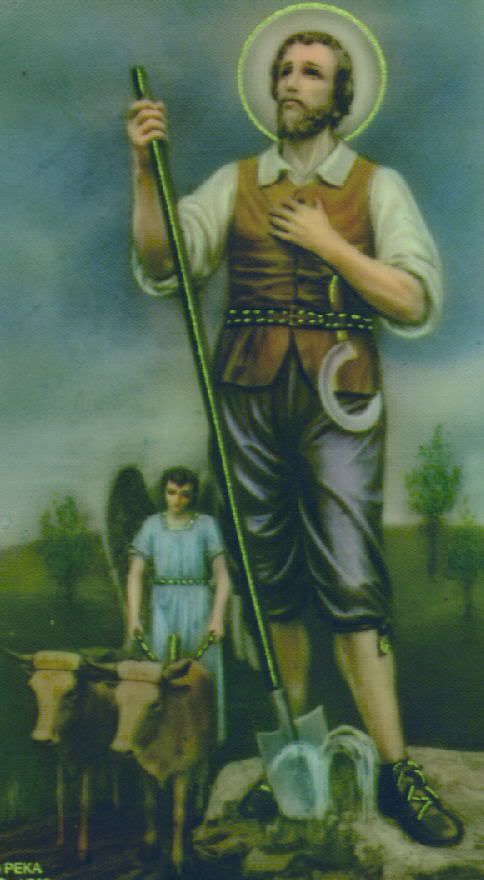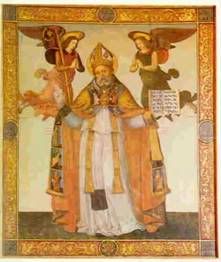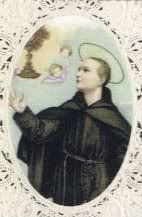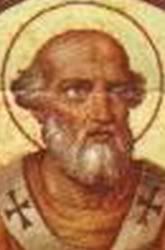MAY 25
The current Roman calendar lists three saints on May 25. Their stories are briefly presented here, one after another.

VENERABLE BEDE This English priest is famous as a saint, a priest, a monk, a teacher and a writer of history. He was born in England in 673. His parents sent Bede to the local Benedictine monastery to receive an education. He loved the life of the monks so much that when he grew up he became a monk. He remained in that same monastery for the rest of his life.
St. Bede loved the Holy Bible very much. He tells us that it was a joy for him to study the Bible. He loved to teach it and write about it. When he grew older, sickness at last forced him to stay in bed. His pupils came to study by his bedside. He kept on teaching them and working on his translation of St. John's Gospel into English. Many people could not read Latin. He wanted them to be able to read the words of Jesus in their own language.
As he grew sicker, St. Bede realized that he was about to go back to God. The monks would miss him very much. He kept on working even when he was seriously ill. At last, the boy who was doing the writing for him said, "There is still one sentence, dear Father, which is not written down." "Write it quickly," answered the saint. When the boy said, "It is finished," the saint said, "Good! You are right-it is finished. Now please hold my head up. I want to sit facing the place where I used to pray. I want to call on my Heavenly Father."
St. Bede died shortly after, on May 25, 735. His most famous book, Church History of the English People, is the only source for much of early English history. People call Bede by the respectful title of "venerable." He is also a Doctor of the Church.

ST. GREGORY VII
This pope's name was Hildebrand. He was born in Italy around 1023. His uncle was a monk in Rome so Hildebrand went to the monastery to be educated. Later, Hildebrand became a Benedictine monk in France. Soon, however, he was called back to Rome. There he held very important positions under several popes until he himself was made pope.
For twenty-five years, he had refused to let himself be elected. But when Pope Alexander II died, the cardinals made up their minds to elect Hildebrand pope. With one voice they cried out: "Hildebrand is the elect of St. Peter!" "They carried me to the throne," the saint wrote afterward. "My protests did no good. Fear filled my heart and darkness was all around me." Hildebrand chose the name Gregory VII.
These were truly dark times for the Catholic Church. Kings and emperors were interfering in Church matters. They named the men they wanted to be bishops, cardinals and even popes. Many of those appointed were not very good men. They were bad examples to the people. The first thing Pope St. Gregory did was to spend several days in prayer. He also asked others to pray for him. He realized that without prayer nothing can be done well for God. Afterward, he began to act to make the clergy better. He also took steps to keep civil rulers out of the affairs of the Church. This was very difficult because the rulers were all against the change. However, some gave in.
One ruler, Emperor Henry IV of Germany, caused Pope Gregory great sufferings. This young man was sinful and greedy for gold. He would not stop trying to run the affairs of the Church. He even sent his men to capture the pope. But the people of Rome rescued the saint from prison. Pope Gregory excommunicated the emperor. That did nothing to stop Henry IV. He chose his own pope. Of course, the man he chose was not the real pope. But Henry tried to make people think he was. Then, once again, the emperor sent his armies to capture the saint. Pope Gregory was forced to leave Rome. He was taken safely to Salerno where he died in 1085. His last words were, "I have loved justice and hated evil. That is why I am dying in exile." He was proclaimed a saint by Pope Paul V in 1606.
Pope Gregory VII (Hildebrand) is known for his tremendous personal courage. He stood up for the cause of Jesus and his Church.
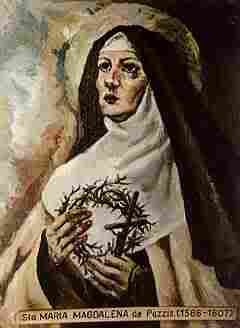
ST. MARY MAGDALEN DE PAZZI Catherine de Pazzi was born in Florence, Italy, in 1566. She was the only daughter of very rich parents. When she was fourteen, Catherine became a boarder at a convent school. There she grew to love life in a religious house. But about a year later, her father took her home. He began to think of choosing a rich husband for her. However, Catherine's heart was set on becoming a nun. She shocked her parents by telling them she had already made a vow of chastity. They could not believe it. Finally, they let her enter the Carmelite convent. Only fifteen days later, however, they came and took her home. They hoped to make her change her mind. After three months of trying, they gave up. They let her go back for good, with their blessing. It was 1582, the year St. Teresa of Avila died in Spain.
As a novice, St. Mary Magdalen became very sick. The nuns feared she might die. She was permitted to pronounce her religious vows. Since she was suffering greatly, one of the sisters asked her how she could stand that pain without a word. The saint pointed to the crucifix. She said: "See what the great love of God has suffered for my salvation. This same love sees my weakness and gives me strength."
St. Mary Magdalen had great sufferings her whole life. She also had very strong temptations to impurity and to greed for food. She overcame everything by her great love for Jesus in the Holy Eucharist and for Mary. Often she ate only bread and water. She practiced other acts of self-denial, too. Moreover, her love for Jesus became so great that she would say, "Love is not loved, not known by his own creatures." With tears, she would pray and offer her pains for sinners and unbelievers, right up until she died. She once said: "O my Jesus, if I had a voice loud and strong enough to be heard in every part of the world, I would cry out to make you known and loved by everyone!"
St. Mary Magdalen de Pazzi died on May 25, 1607, at the age of forty-one. She was proclaimed a saint by Pope Clement IX in 1669.
